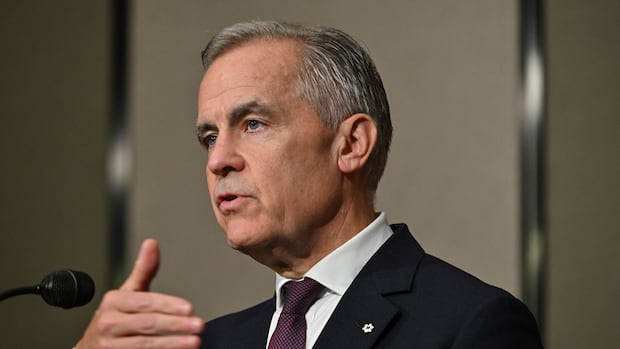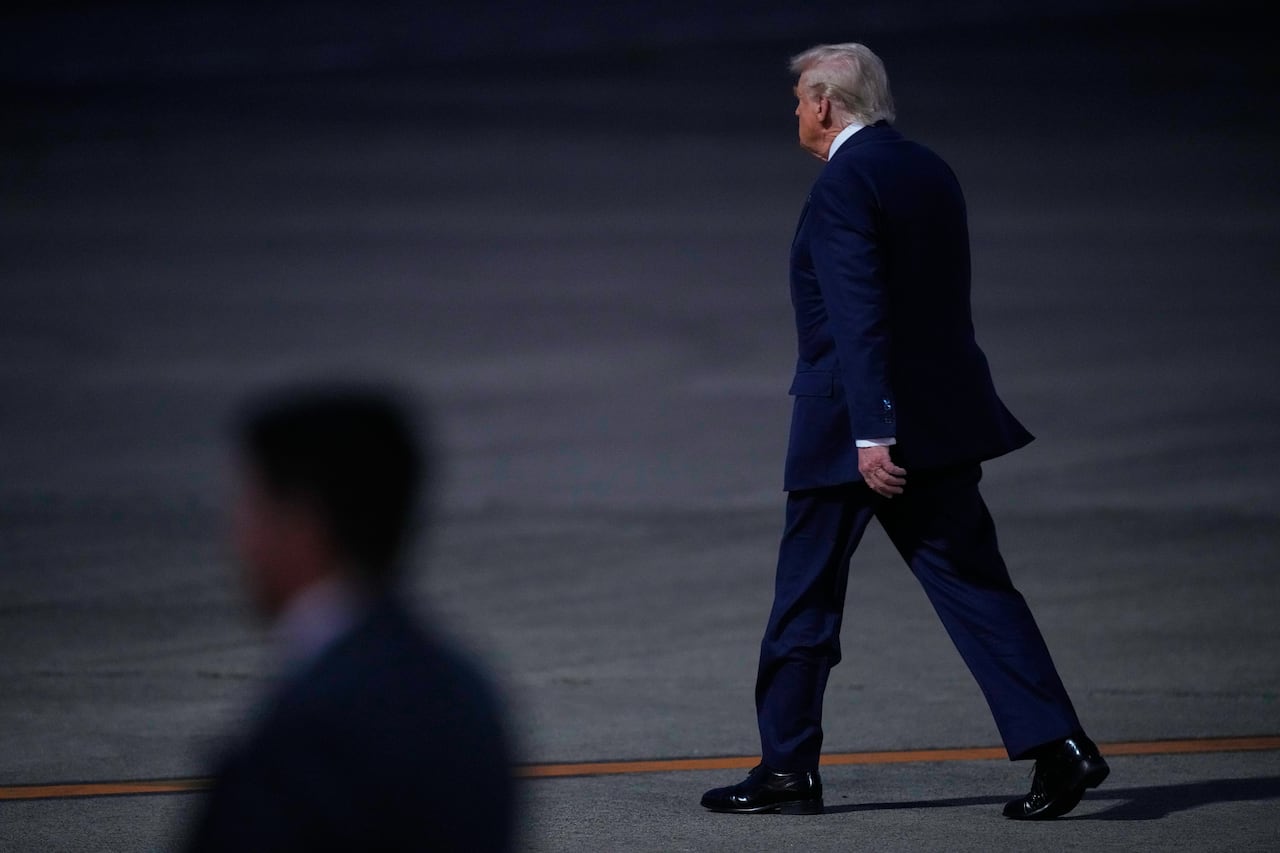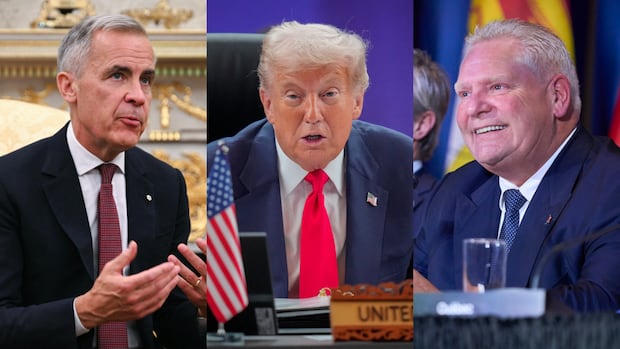Mark Carney and Donald Trump have not spoken since trade talks were cancelled last week, the prime minister confirmed Monday, but he said he'd always make himself available to talk with the U.S. president — as he would for any other world leader.
It’s a sign that not only are trade negotiations between Canada and the United States on ice, but the much-hyped personal rapport between the two leaders is in the deep freeze as well.
Carney visited the Oval Office just a few weeks ago, and there was friendly banter and the expectation that a deal on sectoral trade issues was at hand. But all of that came crashing down last Thursday with Trump's cancellation of negotiations over an Ontario government-sponsored, anti-tariff television ad, which uses excerpts from a four-decade-old address by former U.S. president Ronald Reagan.
Canada was making important progress at the negotiating table before the ad began running in the United States, the prime minister said.
But Carney declined to criticize Ontario Premier Doug Ford, saying in the end, the federal government is the one in the room conducting the negotiations.
"Others will have opinions and … [I] welcome free advice. Unsolicited advice is entirely appropriate; every Canadian is a stakeholder in these negotiations,” Carney told reporters at the conclusion of the ASEAN summit in Kuala Lumpur.
"In any complicated, high-stakes negotiation, you can get unexpected twists and turns, and you have to keep your cool during those situations," he said."It doesn't pay to be upset. Emotions don't carry you very far."
WATCH | Carney asked about Trump's reasoning for cutting off trade talks:

Carney asked about Trump’s reasoning for cutting off trade talks
1 hour ago |Duration
Trump has no plans to meet with Carney
While flying between Malaysia and Japan on Monday, Trump was clearly still angry about the ads and indicated he’s not interested in any discussion with Carney.
“I don’t want to meet with him,” Trump told reporters on Air Force One. “I’m not going to be meeting with him for a long time.”
The U.S. president has also threatened to impose an additional 10 per cent tariff on Canada, over and above the ones already in place, as punishment for Ontario not immediately pulling the ads.
The federal government has yet to see the specifics though, Carney said, in terms of an executive order from Trump creating the new duties.
Trump was asked when he intends to follow through on his threat, but declined to say: “I don’t know when it’s going to kick in. We’ll see.”
It’s been suggested by some of Trump’s senior advisers and the Business Council of Canada that the Ontario government ads are just the tip of the iceberg when it comes to U.S. frustration with Canada on a range of issues, some of them not even trade-related.
Carney, however, disagreed. “I would suggest you take the president at his word,” he said.

Much of the prime minister’s trip to the Indo-Pacific has been about diversifying trade away from the United States and forging closer ties with ASEAN countries.
Speaking to a business audience on Sunday, the prime minister suggested that despite protectionism in Washington, there’s still hope for free trade elsewhere.
“There are a lot more countries by GDP that are willing and keen to continue to have relatively open trade; certainly to have rules-based trade, to respect rules-based trade,” he said.
Carney also said he believes trade will shift away from the United States over the short-term as the world adjusts to the new global system.
“It's also shifting because it's more expensive to trade with the U.S. — that's what a tariff does,” Carney told the business executives during a fireside chat.
“But all of that said, the United States is the world's largest. It is the most dynamic economy. It is a source of constant innovation. And everyone, very much Canada included, is going to want to be active.”
WATCH | Rosemary Barton Live on what will get the Canada-U.S. trade talks back on track: 
What will get Canada-U.S. trade talks back on track?
October 26 |
Duration 27:21
Chief political correspondent Rosemary Barton discusses where trade talks go after Ontario Premier Doug Ford’s U.S. ad, with the Sunday Scrum panel of Globe and Mail reporter Ian Bailey, CBC Radio’s The House host Catherine Cullen and Toronto Star’s Queen’s Park bureau chief Robert Benzie. Plus, P.E.I. Premier Rob Lantz, former Canadian ambassador to the U.S. Frank McKenna and Justin Trudeau’s former deputy chief of staff, Brian Clow, join the show to discuss trade negotiations.
A late addition to the prime minister’s schedule on Monday saw him meeting with the president and CEO of Petronas Group, Tsan Sri Tengky Muhammad Taufik. The company is looking to expand its international investments to help support rising demand for liquefied natural gas in Asia. The first shipment to Asia by LNG Canada happened last June.
Focus on military
On Monday, the prime minister also toured CAE’s aviation training centre in Kuala Lumpur; the Montreal-based company will be the AirAsia Group’s exclusive training partner until 2036.
Malaysia singled out Canada this year as a potential strategic partner for developing its defence-industrial base. Ottawa and Kuala Lumpur are negotiating a new defence co-operation agreement to succeed a framework signed in 2013.
Canada has long been involved in training the Malaysian military, but the new agreement is expected to expand naval co-operation, including more frequent Canadian Navy presence in Malaysian waters and exercises with the Royal Malaysian Navy.
There's rising concern in the country about China's military buildup in the South China Sea, but Malaysian Prime Minister Anwar Ibrahim has emphasized dialogue, non-confrontation and a stable bilateral relationship with Beijing, rather than open military rivalry.
Ibrahim has also urged ASEAN not to single out China over regional disputes.
Even still, Malaysia has been concerned enough to upgrade its maritime defences, including radars, drones and the construction of new naval bases in the country's east.
Four years ago, Malaysia’s Foreign Ministry announced that 16 Chinese military transport-aircraft had violated the country’s Exclusive Economic Zone (EEZ) and were conducting “suspicious” activity in the South China Sea.
The Luconia Shoals region is a major flashpoint. China claims jurisdiction within its “nine-dash line” around that area, whereas Malaysia administers the Shoals and its EEZ.

